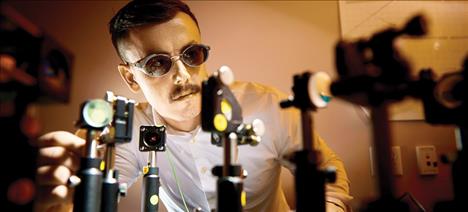MSU receives $26.7 million grant to test, promote quantum technology
Hey savvy news reader! Thanks for choosing local.
You are now reading
1 of 3 free articles.
BOZEMAN — With a new $26.7 million grant from the U.S. Air Force, Montana State University will establish a facility with the mission of moving advanced quantum technology applications in cybersecurity, communications technology and national defense from concept and testing to market.
The 20-month grant from the Air Force Research Laboratory in Rome, New York, will support MSU’s Applied Quantum CORE facility, to be located at the MSU Innovation Campus within the INDUSTRY Bozeman building, which is currently under construction. The grant funding will purchase equipment to test prototype quantum components in the extremely cold environments in which they operate.
Yves Idzerda, a physicist and dean of MSU’s College of Letters and Science who is the grant’s principal investigator and the administrator of MSU’s Applied Quantum CORE, said the new facility will aid the incorporation of quantum science into technological applications to benefit the government and private sectors. CORE stands for Capacity and Operational Resilience and regional Equity.
“Montana State University is a leader in the quantum field,” Idzerda said. He added that Montana is a great place to start small companies in the specialty because of the groundwork in quantum materials already laid at MSU.
Quantum physics deals with the behavior of very small particles, smaller even than the protons and neutrons most people know as the parts that make up atoms. Scientists – including those at MSU’s photonics Spectrum Lab and the MonArk Quantum Foundry, which is led by MSU and the University of Arkansas – are discovering how to manipulate quantum particles to create faster, more sensitive and more precise systems in electronics, including sensors, location systems, computers and medical equipment.
The Applied Quantum CORE facility will nurture scientists and entrepreneurs attempting to incorporate those advances into useful components and devices, Idzerda said.
“We will have a facility with this testbed, and it will be available to anybody who collaborates with researchers in the Q-CORE, the MSU Spectrum Lab, the MonArk Foundry, or one of the groups here at Montana State University,” he said.
The facility will house specialized devices called dilution refrigerators, which are used in labs to achieve extremely cold temperatures close to absolute zero, which is minus 273.15 degrees Celsius or minus 459.7 degrees Fahrenheit. Absolute zero is the lowest temperature possible, where even “the little vibrations in atoms go away,” Idzerda said, thereby minimizing or eliminating certain phenomena, like electrical resistance.
In order to take advantage of that condition, quantum components must be able to withstand those very, very cold temperatures. Because dilution refrigerators like those coming to the Applied Quantum CORE facility are very expensive, many commercial components being developed have never been tested in those extreme environments, Idzerda said.
“What we will do is test new devices that people create and we’ll find out what the faults are with some of them,” Idzerda said.
After devices are tested, the Applied Quantum CORE facility will help troubleshoot components and refine the ones that show promise. The facility’s business accelerator division will help with further development of experimental components into viable devices, and the Applied Quantum CORE’s incubator division will help clients find further capital investment and assist with product development and marketing.
“There’s a lot of science driving this, but the next phase is economic development,” Idzerda said. “How do we take these ideas, which the first phase funded, and turn them into a product or into a company? That’s really what we’re headed for in the long run.”
Idzerda said Dan Miller, MSU engineering professor and former dean of the Jake Jabs College of Business and Entrepreneurship, will lead the economic development arm of the facility. Suzi Taylor, currently director of MSU’s Science Math Resource Center, will focus on workforce development.
Idzerda said the Applied Quantum CORE will employee about 10 staff members. Krishna Rupavatharam, associate director of Spectrum Lab, has been named the facility’s science lead.
Idzerda credited Jayne Morrow, formerly of MSU’s Office of Research and Economic Development, with the idea of creating a facility that would focus on turning research projects into segments of the growing research enterprise in quantum materials in Montana and the surrounding region.
“We’d like to draw from the middle of the country, from those places that don’t have the resources that would allow them to have this low-temperature capability, but they do have good ideas,” Idzerda said.
Alison Harmon, MSU vice president for research and economic development, said the grant is among the most significant directed grants ever received by MSU researchers.
“We will put it to good use, investing in the technology testing facility that will help bridge gaps in bringing innovations to market,” she said. “Montana State’s leadership in quantum science will benefit the state and the regional economy as the Applied Quantum CORE provides resources that small businesses could never develop on their own. I am very proud of the researchers who have made this vision a reality.”
















